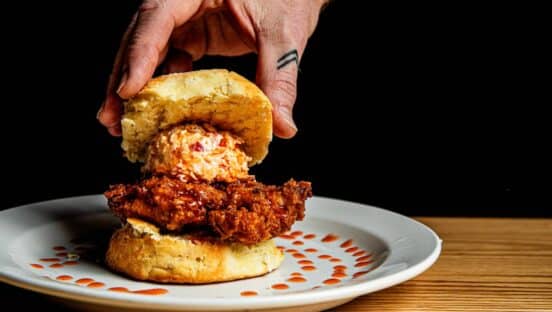Numerous brands have repositioned themselves during the pandemic, but Schlotzsky’s had a head start.
Before most of the country even knew what COVID was, the 340-unit sandwich chain—owned by Focus Brands since 2006—was reducing slow menu items and concentrating on core pizza and sandwich offerings, or as COO Tory Bartlett calls it, “focusing on doing a few things great.” Operations were streamlined to improve speed of service and accuracy.
Schlotzsky’s used Delphi Display Systems’ drive-thru timers to see from an enterprise level how stores were performing and to find opportunities throughout the customer journey. In addition, drive-thru menu boards were adjusted to suggestively sell items that would perform well and that could be produced quickly.
The targeted efficiencies have meshed well with a system that already leans heavily into off-premises. Eighty-five percent of stores have a drive-thru, and nearly 100 percent participate in third-party delivery. Curbside pickup, which wasn’t available prior to COVID, is also available through the mobile app. When those are thrown into a bowl and mixed with mass closure of dining rooms, dollar signs begin to appear.
“So it was almost like we had a crystal ball because we got the franchise system working on [efficiencies], and it really helped us,” Bartlett says. “… So obviously with most of our dining rooms closed pretty much right away—and even today, we have some of them still closed—the business really shifted to the drive-thru and our other channels quickly. So the brand is doing really, really well.”
Schlotzsky’s push toward drive-thru—a channel that’s grown 40 percent during COVID—is quite serious. It’s so significant that the brand has been working on prototypes for more than a year, even before the pandemic instructed it to do so.
The COVID crisis simply reshaped the approach.
“We started looking at the business and the trends and just realized that here’s a great opportunity for just really leaning into drive-thru,” Bartlett says. “… Prior, the brand’s been building larger prototypes and larger restaurants. You see a lot of brands struggling to position themselves with real estate across a lot of different markets. And the markets that we were looking at, everybody is looking for an acre with ingress, regress. We just realized there’s an opportunity to build something smaller and maybe be able to take advantage of some of these partials that were leftovers, but are still really good real estate—0.6, 0.7 of an acre.”
The first prototype is a 1,000-square-foot drive-thru only concept that has pickup windows on two sides. One side is a traditional drive-thru with a six-car stack. The other side is flexible enough to be used as a second drive-thru, curbside pickup area, or for third-party delivery staging.

The other prototype is 1,800 square feet with a traditional drive-thru and 35 seats. Bartlett says that with this layout, designers placed much thought into the guest journey as they come through the restaurant, including a view of freshly baked bread as customers walk inside.
A company store in Oklahoma will open a prototype in late spring or early summer. Additionally, Midwest franchisee JJ Ramsey—who operates locations across Arkansas, Missouri, and Kansas—signed a deal to open four prototypes.
“By redesigning the building and setting the line up differently, we’re able to do what we do with less people, which is obviously important in today’s environment, but still be able to deliver the speed and the accuracy that the consumers demand,” Bartlett says.
Going forward, Schlotzsky’s expects 99 percent of new restaurants to have a drive-thru. Bartlett notes that current stores won’t be retrofitted because the 15 percent of stores that are non-drive-thru are usually in-line or constrained by real estate in some manner.
Drive-thru restaurant visits grew by 26 percent in April, May, and June, and represented more than 40 percent of visits in that three-month span, according to the NPD Group. Even after dining rooms reopened, drive-thru occasions grew by 13 percent in July, which was the highest growth among on-premises, carryout, and delivery channels.
Because of that industry-wide growth, Schlotzsky’s isn’t alone in betting on the future of drive-thru. Major players like Chipotle, Shake Shack, and Qdoba are increasing their investment on the channel. With higher demand for land with drive-thru capabilities, flexibility will become crucial, Bartlett notes.
“You’re going out and competing with not just restaurant space—I mean banks and all these others for these hard corners and one-acre parcels,” Bartlett says. “And as developers come in and they develop these properties, there’s a lot of opportunity for these 0.6, 0.7-point acres. I wouldn’t even call them leftovers, but they’re hard-to-use spaces. That’s where our model sits in. Because if you have good visibility, you still have good ingress and regress, and can have your drive-thru, it could be a really nice addition to the developments where their main focus is selling these larger parcels.”
The emphasis on drive-thru fits into Schlotzsky’s overall goal to reach 400 stores by the end of 2023. Bartlett says the brand is focused on the Midwest, Southeast, and Southwest and will look to fill in white space with both current and new franchisees.
Bartlett says he isn’t sure the restaurant industry will ever return to normal. There will be some adjustments, but for the most part, he believes consumers and have gotten used to the idea of convenience. Schlotzsky’s is simply preparing for that future.
“That’s why we’re leaning pretty hard into these models,” Bartlett says. “And obviously there’s still going be a demand for consumers that want to come in and sit in and enjoy their meal at the table, and we’ll have that for them. … But for our system to be successful, we have to recognize and understand that consumers are going to consume our food outside of our locations more than likely the majority of the time.”






